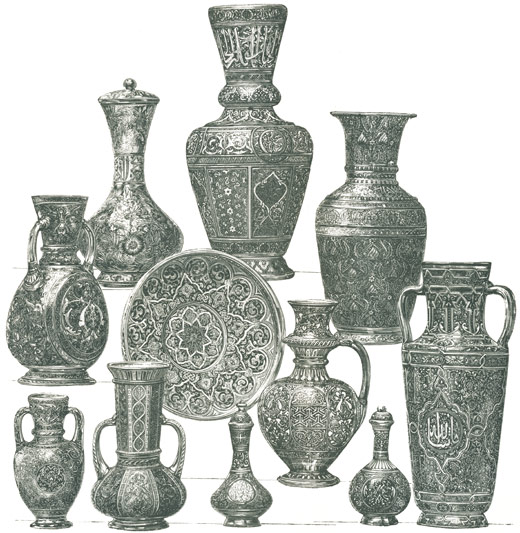Vienna. I cannot say, however, that I particularly admired the design, as to me it seemed heavy and awkward.
Several services of crystal cut glass, painted in black colors of different patterns, were also exhibited. The contrast of a brilliant surface with black decorations I consider a bad effect, not pleasant to the eye. Other services cut and painted in light pink looked very handsome.
Articles of white glass engraved, and covered over the engraving with a dead gilding, looked very pretty.
Sets of bluish opal glass painted with white enamel and gold.
Sets of white and yellow glass, in which flakes of white mica have been distributed irregularly.
Sets in turquoise-blue, gilt, and mounted in ormolu.
Fine large vases, subjects painted with gold and colored grounds.
Two very large vases in six pieces, measuring 51 inches, with pedestals; the body of the vase handsomely engraved, and the remainder cut; valued at $3,200 the pair. The different pieces were adjusted one upon the other with such nicety that it was with difficulty one could see the separation. Two handsome glass handles were attached at the sides, and were very regularly put on.
Two heavily cut oval bowls, 10 by 15 inches, cut in diamonds, worth $100 each.
The Austrian cutting is principally flutes and diamonds; sometimes large panels are cut, and upon these heavy sharp diamonds are distributed.
The thin blown glass ware of this house is very well done.
Quite a variety of goods exhibited by this house consist of articles with cutting, painting, and decorations upon the same article. This would indicate that Bohemian glass is hard enough to retain the sharpness of the cutting, even when it is placed in a muffle to bake on the enamels, the gilding, and other decorations.
In colored glass I found a large variety of very superior colored, painted, gilded, enameled, and otherwise decorated articles, all executed in very fine taste, and the colors of the glass excellent.
Two fine vases with ormolu handles, 24 inches high by 11 inches diameter.
An opal set of enameled glass painted over in several colors, making a fine contrast.
A very handsome vase, 4 feet high, of iridescent amber glass, gilded and enameled in white, was sold to the Dublin Museum for $140. Another one of the same style was sold to the South Kensington Museum, of London.
Iridescent glass.
This house is especially celebrated for its iridescent glass, being the pioneer in that line. About twenty years ago it so happened that by using fire works in a furnace where some glass-ware had been placed the metallic vapors of these fire works produced a peculiar iridescent color upon




